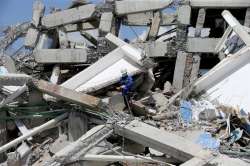Indonesia earthquake tsunami: Mass burials commence after deadly catastrophe rampages many areas, officials struggling to provide relief
As per the latest reports, the death toll has risen to 832 and is expected to rise.

Authorities in Indonesia have commenced mass burials for the victims of the deadly earthquake and tsunami that killed over 800 people.
As per the latest reports, the death toll has risen to 832 and is expected to rise.
Local Army Commander Tiopan Aritonang said that 545 bodies would be brought from one hospital alone. The grave being dug in Palu will be 10 meters by 100 meters (33 feet by 330 feet) and can be enlarged if needed, said Willem Rampangilei, chief of Indonesia’s National Disaster Mitigation Agency.
“This must be done as soon as possible for health and religious reasons,” he said. Indonesia is majority Muslim, and religious custom calls for burials soon after death, typically within one day.
Local military spokesman Mohammad Thorir said the area adjacent to a public cemetery can hold 1,000 bodies. All of the victims, coming from local hospitals, have been photographed to help families locate where their relatives were buried. Video footage showed residents walking from body bag to body bag, opening the top to check to see if they could identify faces.
Around midday, teams of workers, their mouths covered by masks, carried 18 bagged bodies and laid them in a trench. Mechanical earth-movers waited to push soil on top of the bodies. More burials are expected to follow.
Military and commercial aircraft were delivering some aid and supplies to the region. But there was a desperate need for heavy equipment to reach possible survivors buried in collapsed buildings, including an eight-story hotel in Palu where voices were heard in the rubble.
At least 832 people were confirmed dead as of Sunday evening, Indonesia’s disaster agency said, with nearly all of those from Palu. The regencies of Donggala, Sigi and Parigi Moutong — with a combined population of 1.2 million — had yet to be fully assessed.
“The death toll is believed to be still increasing, since many bodies were still under the wreckage, while many have not been reached,” said disaster agency spokesman Sutopo Purwo Nugroho.
The cries from beneath the Roa-Roa Hotel, which appeared to have toppled over with its walls splintered like pickup sticks, went silent by Sunday afternoon. Officials had estimated about 50 people could be inside.
“We are trying our best. Time is so important here to save people,” said Muhammad Syaugi, head of the national search and rescue team. “Heavy equipment is on the way.”
Metro TV showed about a dozen rescuers in orange jumpsuits climbing over debris with a stretcher carrying the body of a victim from the modest business hotel.
Indonesian President Joko “Jokowi” Widodo authorized for the country to accept international help for the disaster, Thomas Lembong, chair of Indonesia’s Investment Coordinating Board, tweeted Monday morning. It wasn’t immediately clear what type of help was being authorized, but the stricken areas needed medical supplies, food and water.
“We will send food today, as much as possible with several aircraft,” he told journalists in the capital, Jakarta, adding a supply of fuel was also set to arrive.
It was the latest natural disaster to hit Indonesia, which is frequently struck by earthquakes, volcanic eruptions and tsunamis because of its location on the “Ring of Fire,” an arc of volcanoes and fault lines in the Pacific Basin. In December 2004, a massive magnitude 9.1 earthquake off Sumatra island in western Indonesia triggered a tsunami that killed 230,000 people in a dozen countries. More recently, a powerful quake on the island of Lombok killed 505 people in August.
In Donggala, the site closest to the earthquake’s epicenter, aerial footage on Metro TV showed the sugary blond sands of beaches swept out to sea, along with some buildings. Some buildings in the town were severely damaged, with plywood walls shredded and chunks of concrete scattered on the pavement. Much of the damage, however, appeared limited to the waterfront.
Palu, which has more than 380,000 people, was strewn with debris from the earthquake and tsunami. A heavily damaged mosque was half submerged and a shopping mall was reduced to a crumpled hulk. A large bridge with yellow arches had collapsed.
The city is built around a narrow bay that apparently magnified the force of the tsunami as the waves raced into the tight inlet. Nugroho, the disaster agency spokesman, said waves were reported as high as 6 meters (20 feet) in some places.
In one devastated area in Palu, residents said dozens of people could still be buried in their homes.
“The ground rose up like a spine and suddenly fell. Many people were trapped and buried under collapsed houses. I could do nothing to help,” resident Nur Indah said, crying. “In the evening, some of them turned on their cellphones just to give a sign that they were there. But the lights were off later and the next day.”
With hundreds injured, earthquake-damaged hospitals were overwhelmed.
Nugroho said 61 foreigners were in Palu at the time of the disaster. Most were accounted for, but one South Korean was believed to be trapped in the Roa-Roa Hotel, while three others from France and one from Malaysia were missing.
Indonesia is a vast archipelago of more than 17,000 islands home to 260 million people. Roads and infrastructure are poor in many areas, making access difficult in the best of conditions.
The disaster agency has said that essential aircraft can land at Palu’s airport, though AirNav, which oversees aircraft navigation, said the runway was cracked and the control tower damaged.
(With AP inputs)